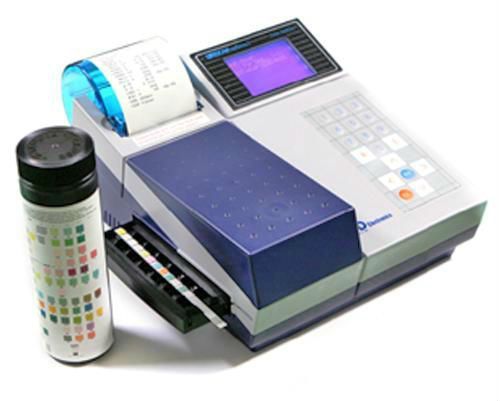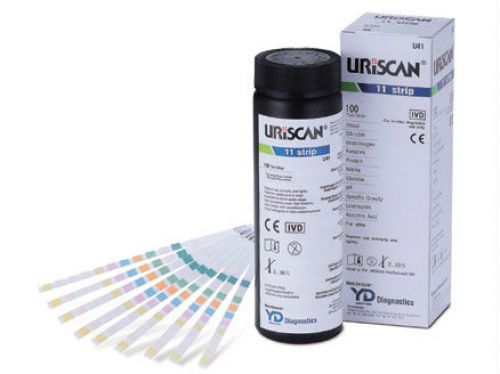To date, active development of diagnostic medicine, becomes in some measure a result of the growth in the number of patients endocrine, infectious, cancer.
One of the most important ways to diagnose a number of pathologies are test strips for urine analysis.
Moreover, of particular importance in their application, is the possibility of carrying out of diagnostics in house conditions without the use of an analyzer used in medical institutions.
What are the test strips
Diagnostic test strips for urine analysis are one or more chemical reagents used in laboratory research in the hospital, deposited on a substrate made of plastic or heavy paper with a size of 0.5 to 6-13 inches.
The application area of the reagent also serves as a test indicator that changes color in contact with elements of organized sediment contained in the urine.
The choice of reagent depends on what disease need to be identified. Test strips can only have one deposited on the surface of the reagent, in this case, you can check the concentration of one metabolite (adnoidectomy), or have a scale of different reagents, for comprehensive examination of the state of the organism (multiple indicator).
The set of test strips for urine are:
- plastic tube designed to hold 25 to 150 strips;
- instructions for use;
- the sorbent to absorb excess moisture;
- cardboard box;
- the color scale for correct interpretation of the results of the analysis (often, the scale applied to the tube).
Purpose
Test strips are designed to perform Express-analysis of urine in the home and using analyzers to determine its qualitative and quantitative characteristics.

The definition of the qualitative characteristics is to identify any element, evidencing the existing pathology. The color change of the indicator, clearly indicates the presence of a metabolite and is considered a positive reaction. Semi-quantitative characterization is to determine the number of these inclusions (concentration) by visual estimation of the degree of coloration of the reagent.
Analyzers used in laboratories of medical institutions, as they allow you to instantly read up to 13 results with one of the strips and conduct more than 500 tests per hour
Use test strips to monitor the condition diagnosed previously with the disease, and to detect the following pathological States:
- diabetes mellitus;
- glycosuria in pregnancy;
- infectious diseases of the upper or lower urinary tract;
- urinary tract diseases of noninfectious nature;
- urolithiasis.
Express-method of self-diagnostics with visual indicators, unable to fully replace the full analysis made in the laboratory.
The types of test strips
Today many countries produce flat strips.
The most famous include:
- Bioscan (Russia);
- Biosensor (Russia);
- Uriscan (Korea);
- Multicheck (Canada);
- Mcral-Test (Switzerland);
- UrineRS (USA).

Each manufacturer provides a wide range of diagnostic kits able to explore a variety of options:
- glucose;
- ketone body;
- pH;
- the red blood cells;
- protein;
- leukocytes;
- density;
- the urobilinogen;
- bilirubin;
- nitrites;
- creatinine.
Uriscan strip can have from 1 to 11 indicators printed on the test strip
The combination of several reagents on a single strip allows to optimize the diagnostic process depending on the task. For example, to monitor the status of diabetes, the strips applied to the indicators of the presence of glucose and ketone bodies.
If you suspect development of diabetic nephropathy, it is advisable to use a strip that combines the following indicators:
- blood;
- protein;
- nitrites;
- glucose;
- ketones.
As a rule, all manufacturers produce the rapid tests are used both for visual study and instrumental (using the analyzer).
Rules for the use of
During the test, you should follow some rules, the violation of which can lead to distortion of the results:
- it is impossible to touch the indicator (in the area of application of the reagent);
- the procedure should be carried out at room temperature (15-25 °C). At low temperature the rate of passage of the reaction can be significantly reduced, which can lead to false negative results;
- if the urine was stored in the refrigerator should be warmed to room temperature;
- do not store urine, is designed to analyze more than 2 hours, as in this case, changes of its physico-chemical properties, for example, increasing the number of bacteria changes the pH of urine;
- you cannot use a test strip twice;
- you cannot hold the indicator for a long time immersed in urine, because of the probability of leaching reagent test strips;
- after opening the package, the test strips should be used within the deadline indicated on the package (usually 5-6 months);
- do not expose the color scale on prolonged exposure to sunlight, as this can cause it to fade.

If the diagnostic strip has several reagent zones, in the analysis, the urine should be immersed all the indicators, located on the strip
The procedure for conducting diagnostic study can be divided into stages:
- Removing the strip from the tube, tightly closing its lid a.
- Urine, ready for analysis should be thoroughly mixed. This will prevent the settling of some elements and will produce more reliable results.
- Immerse the indicator in urine for 1-3 seconds.
- Removing the strip, remove the excess urine by tapping the edge strips on the edge of the tank.
- While waiting for the reaction, which takes from 0.5 to 3 minutes, depending on the investigated parameters and the manufacturer’s instructions, the strip should be placed on a clean surface, indicator up.
- Interpretation carried out by comparing the obtained result with the color chart supplied with the kit.

Rules for the use of visual test strips, depending on the manufacturer, may have some differences in the waiting time of the reaction, the color of the indicator, the time and conditions of storage
Transcript analysis
Next, the main components of urine, which can be clarified with the help of Express bands and their characteristics.
Leukocytes
Indicators of the presence of leukocytes in urine is used to determine the inflammatory processes in the urinary tract. Upon entry into the reaction reagent applied not the test strip, leukocytes changes color from different options for the source (usually yellow) to purple (with positive reaction).
Glucose
The urine test for sugar are used to determine the extent of the excess concentration of glucose in the blood, as reabsorbiruetsa ability of the kidneys, the filtration of blood plasma does not cope with sugar level above 8.9 mmol/L.
Basically, the increase of sugar in the urine occurs in diabetes. The staining reagent in the color range from green to brown indicates the presence of glycosuria.
The increase of sugar in the urine of the pregnant woman is not always indicative of the development of diabetes and may be associated with temporary dysfunction of the renal apparatus.
Ketone bodies
Ketone bodies are the result of fatty acid oxidation, increased concentrations caused by lack of carbohydrates (malnutrition), or inability of tissues to utilize glucose (diabetes).
A condition in which there is a high concentration of ketone bodies, called ketoacidosis. Its development shows the change in strip color from pale pink to Burgundy color.
Proteins
Strips for the determination of protein used in the first place, if you suspect a patient has renal failure. The reaction is based on the ability of tetrabromphenol blue, included in the reagent to react with the albumin (protein), generating a colored complex.
A positive reaction is characterized by color change from pale yellow to intense green. Minimal sensitivity to the concentrations of protein in the urine 0.06 g/L.
Blood
Indicator scale in the diagnosis of latent hematuria, may have one or two sectors, responsive to the presence of hemoglobin or intended to be a comprehensive analysis of the presence of red blood cells and free hemoglobin. Minimum determined threshold may vary, depending on the manufacturer, 5 to 10 erythrocytes per 1 µl and 10 mg of hemoglobin per 1 ál.
To perform a complete analysis for the presence of blood in the urine, the color scale should consist of two sectors (hemoglobin and erythrocytes)
If a positive reaction occurs color change of the reagent in the first sector point, the second a uniformly colored background from yellow-green to dark green (blue).
Due to the fact that hematuria is often accompanied by the appearance in urine of proteins, it is advisable to use the strips, combining reagents for hematuria and proteinuria.
Acidity
Determination of acidity of urine in the home is the easiest way to find out the pH level of the body, which is an integral part of homeostasis. Also, the acidity of the urine determines the prevalence of certain types of salts and crystals, which is especially important in the diagnosis and treatment of urolithiasis. Colour fluctuations in the measurement of pH occurs in the range of orange (acidic) to blue-green (alkaline).
Density
Urine test for density (unit weight) is used for examination of drug-dependent patients as well as athletes suspected of doping. The normal specific gravity of urine ranges from 1,010 to 1,025. The increase of density is observed in inflammatory kidney diseases, diabetes, renal failure.
The urobilinogen and bilirubin
Increasing the concentration of urobilinogen and bilirubin indicate liver and biliary tract. The scale of measurement of urobilinogen has a minimum value of 2 mg/l and a maximum of 80 mg/L. the increase in the content causes an increase in color intensity scale. A positive test result for bilirubin may indicate the development of hepatitis.
Creatinine
Test strips to determine the level of creatinine is used when you suspect the development of impaired renal function, diabetes, hormonal disorders. Creatinine is directly involved in energy metabolism of tissues, and its concentration depends on the amount of muscle mass.
Due to the fact that the volume of muscle tissue on average stable, the creatinine concentration, is also constant.

The increases of creatinine in the urine can be caused by:
- renal failure;
- dehydration;
- physical activity;
- a meat diet.
Nitrites
There are two causes of nitrites in the urine:
- as a result of the activity of bacteria (in this case, diagnose bacteriuria);
- as a result of eating foods that contain high amounts of nitrates.
Typically, detection of nitrites indicates the development of urogenital infection.
Aggregated diagnostic indicators, the colors of which can have slight differences
Despite the simplicity and accessibility, the use of test strips is not without risk of receiving false results, however, compliance with the rules of use of diagnostic tools will help to minimize the risk of errors.




Have you ever considered about including a little bit more than just your articles?
I mean, what you say is valuable and everything. Nevertheless think of if you added some great visuals or videos to give your posts more, “pop”! Your content is excellent but with images and videos, this website could undeniably be one of the greatest in its field. Terrific blog!
Hello my friend! I wish to say that this article is awesome, great written and include approximately all important infos.
I’d like to see more posts like this.
Hi my family member! I wish to say that this post is awesome, nice written and come with almost all important infos. I’d like to look extra posts like this.
I went over this web site and I think you have a lot of superb info , saved to my bookmarks (:.